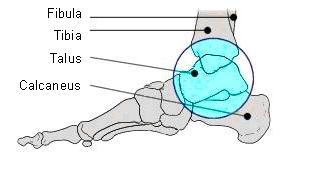Ankle anterior impingement
What is anterior bony impingement?
Anterior bony impingement occurs when bone spurs have grown along the front lip of the tibia and the top edge of the talus as a response to micro-traumas. The soft tissues surrounding the joint may rub or catch against these bony outgrowths and become inflamed. The spurs will reduce your ankle movement, particularly when you try and pull your foot up towards you (called dorsiflexion).
What causes it?
The bone spurs are caused by repeated, small traumas to the bone which occur during activity, particularly sport. It is often seen in athletes who repeatedly bend their foot upwards or make lunging movements, such as footballers, basketball players and dancers.
How does it feel?
You will have pain and swelling on the front of the ankle, which will be worse after activity. The pain will often reduce or go away with rest. It may feel as if something in your ankle is ‘catching’ when you move your foot.
Diagnosis
Your doctor will ask you about your medical history, and he will make a physical examination of your foot and ankle, checking your movement and the location of the pain. He will ask for X-rays to show the size and position of the bone spurs.
Treatment – conservative
There is no conservative treatment – until the bone spurs are removed the tissues will continue to catch and rub.
Treatment – surgical
Arthroscopic Debridement: your surgeon will make two small incisions over the area of impingement. Through one he will insert a fibre-optic camera to look into the joint, and through the other, he will pass the surgical instruments. He will remove the bone spurs and any inflamed soft tissue, and then he will close the wounds.
Rehabilitation after surgery
You may need to wear an ankle brace and walk with crutches for the first few days, gradually increasing the weight on your foot. After a week, you will begin physiotherapy doing stretching exercises, and then move on to muscle strengthening, balance, and restoring a full range of movement.
When will I be back to normal?
Office workers can return to work after a week, manual workers after 4 weeks, depending on their progress with physiotherapy. You should be able to drive after 7 days, and should be able to start playing sport again after about 6 weeks, depending on your recovery.
